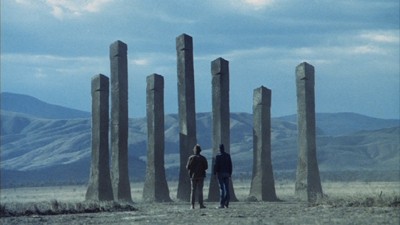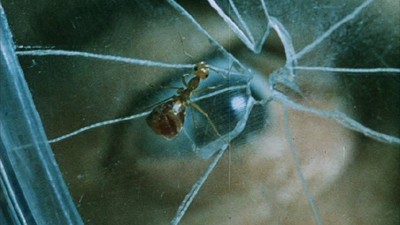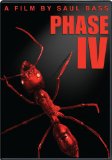| Reviews & Columns |
|
Reviews DVD TV on DVD Blu-ray 4K UHD International DVDs In Theaters Reviews by Studio Video Games Features Collector Series DVDs Easter Egg Database Interviews DVD Talk Radio Feature Articles Columns Anime Talk DVD Savant Horror DVDs The M.O.D. Squad Art House HD Talk Silent DVD
|
DVD Talk Forum |
|
|
| Resources |
|
DVD Price Search Customer Service #'s RCE Info Links |
|
Columns
|
|
|
Phase IV
Legend Films // PG // October 1, 2008
List Price: $14.95 [Buy now and save at Amazon]
 "Phase IV" is a killer bug flick upgraded for the downbeat 70s, a small scale B-picture reworked for the post-"2001" hard sci-fi set. This is the only feature directed by the legendary graphic artist Saul Bass, whose careful eye serves the quiet, unhurried story well, while the mix of ecological terror and otherworldly power creates a mystery never solved. This sort of sinister ambiguity leaves the viewer rattled as the story tells of humanity taken down a peg, struggling to barely keep up in a world over which we are no longer master.
"Phase IV" is a killer bug flick upgraded for the downbeat 70s, a small scale B-picture reworked for the post-"2001" hard sci-fi set. This is the only feature directed by the legendary graphic artist Saul Bass, whose careful eye serves the quiet, unhurried story well, while the mix of ecological terror and otherworldly power creates a mystery never solved. This sort of sinister ambiguity leaves the viewer rattled as the story tells of humanity taken down a peg, struggling to barely keep up in a world over which we are no longer master.The film, written by Mayo Simon ("Marooned," "Futureworld"), opens in the aftermath of an unnamed cosmic event, something about celestial bodies aligning and something big passing us by; like everything else, the script here is intentionally vague. The details don't matter. What's important is that while we were busy looking for big changes created by the event, we overlooked the small ones: somehow, it altered the minds of ants across the globe. Just a little at first, just enough to make them more aware, more unified, more aggressive, not enough to get too much of our precious attention. We can call this "Phase I."
Dr. Hubbs (Nigel Davenport) is a scientist studying the sudden increase in ant populations, due mainly to the peculiar drop in the populations of ant predators: spiders, birds, etc. In the American southwest, ants have grown so uncontrollable that they've forced entire towns to flee. They've also taken to building giant dirt monoliths in the desert. But for what purpose? James Lesko (Michael Murphy) is a young mathematician whose work in game theory may hold the key to unlocking the ants' odd behavior.
The duo set up shop in a domed bunker in the middle of the desert, apparently having learned nothing from movies where isolated scientists are easily hunted by deadly creatures. Slowly but surely, the ants, growing smarter by the minute, attack the compound. Hubbs shows no remorse when a chemical counterattack winds up killing a few townsfolk, and shows no concern for the frightened teen girl (Lynne Frederick) Lesko rescues; he's more interested in how the ants managed to evolve so quickly, adapting in a single generation to the poison, responding to the attack by building "mirrors" that will focus the desert heat onto the human's base - a familiar tactic to animals once harassed by sunbeams focused through a magnifying glass.
"Phase IV" smartly balances old genre standbys (the obsessed, unfeeling scientist; the damsel in distress; the strange invaders) and B-movie conventions (show world-shattering events through the eyes of a small cast in a remote location) with the gloom and headiness of the early-1970s sci-fi scene. Simon builds a rather old fashioned beasts-strike-back yarn, then layers it with elements that raise so many questions, all unanswered. Is this an ecological tale, a warning about our treatment of nature? Is it an allegory for grass roots revolution, with the smaller, overlooked masses rising up - and if so, is it fearful or hopeful? (In other words, is Simon rooting for us or the ants?) What do Lesko's efforts to communicate with the ants say about our current status in the universe, where we think we know so much but actually know so little? Do the scientists' individual fates hinge on how they treat their supposed enemies, or is it all a matter of luck, coincidence, and incorrect interpretations of the facts? (Which takes us, of course, right back to the question about what we know versus what we think we know.)
Simon's screenplay pushes all of these questions in between the lines, while Bass is eager to make a film more dependent on a slow, steady tone than obvious shocks. I wonder what audiences must've thought upon seeing the film in 1974, its methodical approach to the plot a far cry from the promises of the movie's poster, which promised "Ravenous invaders controlled by a terror out in space... commanded to annihilate the world!" The movie contains no such hyperbole; even the few scenes that could somewhat be perceived as "action sequences" (a family flees their farmhouse in a moment of chaos) are designed to unsettle, not thrill.
Perhaps the most memorable aspect of the film is Bass' intricate miniature photography, in which he gets us right up close to the ants in their habitat. This footage is stunning in its own right, a glimpse of the insect world on its own level, but Bass takes it further. Long scenes go by with no dialogue or narration, as we simply watch the ants go about their business. Inventive editing helps create the illusion of intelligence and cunning: intertwined shots of a worker ant and a queen play as a wordless (telepathic?) conversation, and our imaginations fill in their possible plans.
Bass also emphasizes the sheer alien-ness of the insects. We're used to seeing ants, but rarely so detailed; they may have just as well been invaders from another planet. They are familiar, yet foreign. And they are countless. One ant is not scary, but billions of them, all together, working as one mass, is horrifying. So much so that eventually one ant alone is enough - it's the harbinger. Eventually, the mere idea of an ant is enough to chill.
 The DVD
The DVDAfter years of being increasingly hard to find on home video, "Phase IV" finally lands on DVD courtesy Legend Films, as part of that studio's deal to distribute budget versions of Paramount titles.
Video & Audio
There's little effort made in cleaning up the picture for this no-frills release, although I don't recall this film ever looking that great. Grain abounds and colors are washed out. Bass' insect photography holds up well. Presented in 1.78:1 anamorphic widescreen, approximating the film's original 1.85:1 format.
The soundtrack is a simple stereo offering, with clear dialogue and clean effects. (The scene involving a lengthy high pitched squeal will drive you nuts, as intended.) Brian Gascoigne's brilliant electronic music score comes through very nicely. No subtitles are provided.
Extras
None.
Final Thoughts
Fans have waited too long for this title, and it's a bit anticlimactic to get it as part of Legend's set of mediocre discs. Still, the movie's the main thing, and that alone makes this disc Recommended. Watch it late at night with the lights out, and you'll get plenty freaked.
|
| Popular Reviews |
| Sponsored Links |
|
|
| Sponsored Links |
|
|
| Release List | Reviews | Shop | Newsletter | Forum | DVD Giveaways | Blu-Ray | Advertise |
|
Copyright 2024 DVDTalk.com All Rights Reserved. Legal Info, Privacy Policy, Terms of Use,
Manage Preferences,
Your Privacy Choices | |||||||















